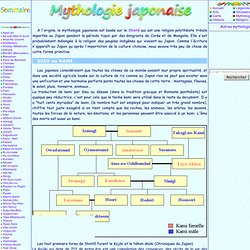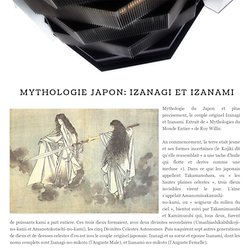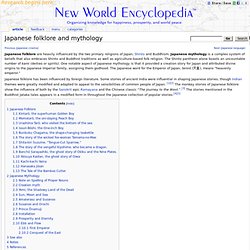

Mythologie japonaise. A l'origine, la mythologie japonaise est basée sur le Shintô qui est une religion polythéiste tribale importée au Japon pendant la période Yayoi par des émigrants de Corée et de Mongolie.

Elle s'est probablement mélangée à la religion des peuples indigènes qui vivaient au Japon. Comme l'écriture n'apparaît au Japon qu'après l'importation de la culture chinoise, nous savons très peu de chose de cette forme primitive. Les japonais considéraient que toutes les choses de ce monde avaient leur propre spiritualité, et dans une société agricole basée sur la culture de riz comme au Japon rien ne peut pas exister sans une unification et une harmonie parfaite parmi toutes les choses de cette terre : montagnes, fleuves, le soleil, pluie, tonnerre, animaux...
La traduction de kami par dieu ou déesse (dans la tradition grecque et Romaine panthéiste) est quelque peu réductrice, c'est pour cela que le terme kami sera utilisé dans le reste du document. Japanese Folktales. Selected and edited by D.

L. Ashliman © 1998-2008 Contents Return to D. The Two Frogs Once upon a time in the country of Japan there lived two frogs, one of whom made his home in a ditch near the town of Osaka, on the sea coast, while the other dwelt in a clear little stream which ran through the city of Kyoto. So one fine morning in the spring they both set out along the road that led from Kyoto to Osaka, one from one end and the other from the other. They looked at each other for a moment without speaking, and then fell into conversation, explaining the cause of their meeting so far from their homes. "What a pity we are not bigger," said the Osaka frog; "for then we could see both towns from here, and tell if it is worth our while going on. " "Oh, that is easily managed," returned the Kyoto frog. This idea pleased the Osaka frog so much that he at once jumped up and put his front paws on the shoulder of his friend, who had risen also. "Dear me! "
Ancient Tales and Folk-lore of Japan Index. Contents Start Reading Page Index Text [Zipped] This is a memorable collection of historical legends and folktales from Japan.

Nearly all of them are set in a well-defined time and place, instead of 'once upon a time.' Themes include ghosts; unrequited love across social boundaries; Shinto landscape, tree and ocean spirits; and tales driven by Bushido and Buddhist ethics. Not a few of these yarns end up with someone committing Seppuku. Smith does not try to dress up the language or narrative for westerners, or sentimentalize the stories.
Each chapter, with one exception, is illustrated by one or more colorful plates done in a typical 19th century Japanese style, all of which are included in this etext. Title PagePrefaceContentsI. Maneki-Neko, le chat porte-bonheur. MYTHOLOGIE JAPONAISE. 15 créatures incroyables de la mythologie japonaise - Linternaute.com Livres. Mythologie Japon: Izanagi Et Izanami. Mythologie du Japon et plus precisement, le couple originel Izanagi et Izanami.

Extrait de « Mythologies du Monde Entier » de Roy Willis. Au commencement, la terre etait jeune et ses formes incertaines (le Kojiki dit qu’elle ressemblait « a une tache d’huile qui flotte et derive comme une meduse »). Dans ce que les japonais appellent Takamanohara, ou « les hautes plaines celestes », trois dieux invisibles virent le jour. L’aine s’appelait Amanominakanushi-no-kami, ou « seigneur du milieu du ciel », bientot suivi par Takamimusubi et Kamimusubi qui, tous deux, furent de puissants kami a part entiere.
Ces trois dieux formaient, avec deux divinites secondaires (Umashiashikabihikoji-no-kami et Amanotokotachi-no-kami), les cinq Divinites Celestes Autonomes. Izanagi demanda a sa soeur comment son corps etait fait. Japanese folklore and mythology. From New World Encyclopedia Japanese folklore are heavily influenced by the two primary religions of Japan, Shinto and Buddhism.

Japanese mythology is a complex system of beliefs that also embraces Shinto and Buddhist traditions as well as agriculture-based folk religion. The Shinto pantheon alone boasts an uncountable number of kami (deities or spirits). One notable aspect of Japanese mythology is that it provided a creation story for Japan and attributed divine origins to the Japanese Imperial family, assigning them godhood. The Japanese word for the Emperor of Japan, tennō (天皇), means "heavenly emperor. " Japanese folklore has been influenced by foreign literature. Japanese Folklore A young Kintarō battling a giant carp, in a print by Yoshitoshi.